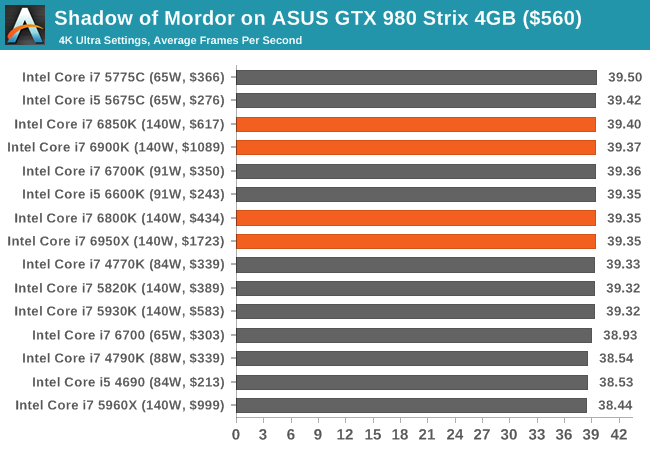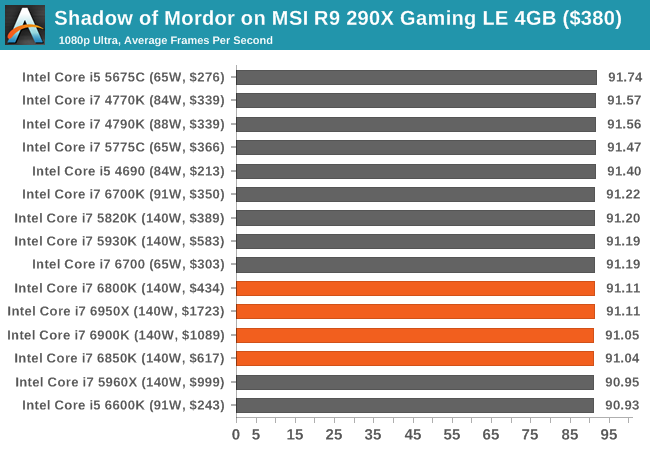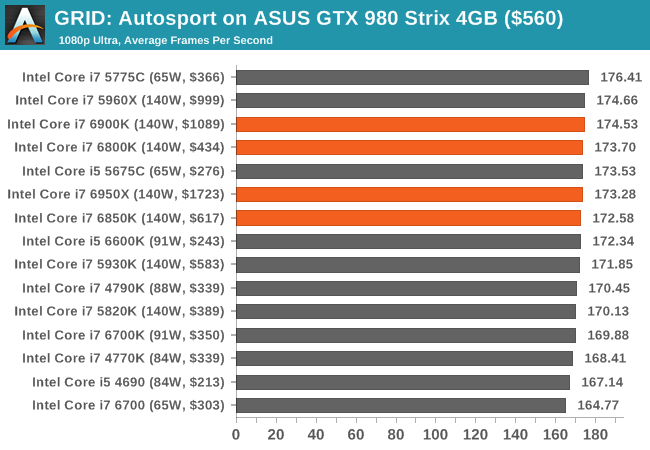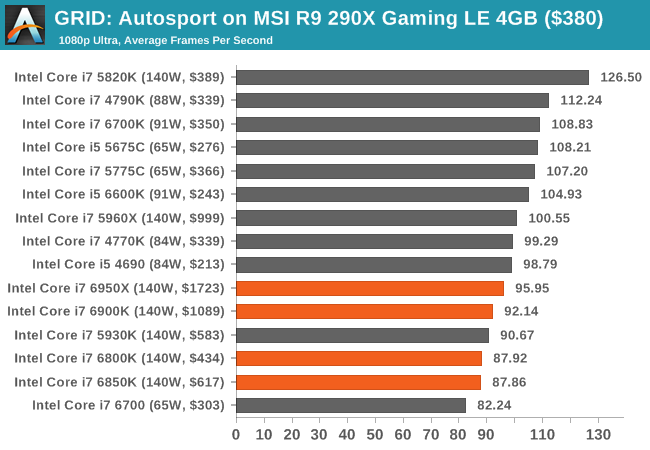The Intel Broadwell-E Review: Core i7-6950X, i7-6900K, i7-6850K and i7-6800K Tested
by Ian Cutress on May 31, 2016 2:01 AM EST- Posted in
- CPUs
- Intel
- Enterprise
- Prosumer
- X99
- 14nm
- Broadwell-E
- HEDT
GRID: Autosport
No graphics tests are complete without some input from Codemasters and the EGO engine, which means for this round of testing we point towards GRID: Autosport, the next iteration in the GRID and racing genre. As with our previous racing testing, each update to the engine aims to add in effects, reflections, detail and realism, with Codemasters making ‘authenticity’ a main focal point for this version.
GRID’s benchmark mode is very flexible, and as a result we created a test race using a shortened version of the Red Bull Ring with twelve cars doing two laps. The car is focus starts last and is quite fast, but usually finishes second or third. For low end graphics we test at 1080p medium settings, whereas mid and high end graphics get the full 1080p maximum. Both the average and minimum frame rates are recorded.
Middle-Earth: Shadow of Mordor
The final title in our testing is another battle of system performance with the open world action-adventure title, Shadow of Mordor. Produced by Monolith using the LithTech Jupiter EX engine and numerous detail add-ons, SoM goes for detail and complexity to a large extent, despite having to be cut down from the original plans. The main story itself was written by the same writer as Red Dead Redemption, and it received Zero Punctuation’s Game of The Year in 2014.
For testing purposes, SoM gives a dynamic screen resolution setting, allowing us to render at high resolutions that are then scaled down to the monitor. As a result, we get several tests using the in-game benchmark. For low end graphics we examine at 720p with low settings, whereas mid and high end graphics get 1080p Ultra. The top graphics test is also redone at 3840x2160, also with Ultra settings, and we also test two cards at 4K where possible.


















205 Comments
View All Comments
Flunk - Tuesday, May 31, 2016 - link
DX12 actually uses the CPU more efficiently so it should make every LESS CPU constrained, not more so.willis936 - Tuesday, May 31, 2016 - link
Well if you want to toss four channels of memory and 28 pcie lanes out the window and just talk about gaming then you should probably keep it in your head that anyone buying these processors over xeons will be overclocking them. You'll likely get identical single threaded performance on the six core parts to the four core parts but just have 2 more cores. If you say more cores doesn't matter in gaming well idk why everyone (including anandtech) is saying this. I play csgo and bf4 @ 1440p120 on a 770/4790k@4.5GHz and while I'm still GPU limited I see all 8 threads get over 70% usage regularly. I have no doubt that even this 4 core single threaded performance king will bottleneck a 1080 in some cases. Intel has slowed down in performance increases and GPUs haven't. The old talk of "you'll always be CPU limited" shouldn't be treated as dogma. Oh and anandtech should consider changing their CPU gaming benchmarks. It's not super helpful to see a bunch of data that shows a dozen CPUs at a dozen scenarios that are all GPU limited. It's not hard to choose realistic CPU limited scenarios.bogda - Tuesday, May 31, 2016 - link
It is difficult now and it has always been difficult finding meaningful, high end, CPU limited gaming benchmarks (unless you are working in Intel marketing/sales). Nobody buys $1000+ processor to run games at 720p.Anybody thinking about buying high end processor for gaming, after seeing meaningful gaming benchmark, should think twice.
P.S. You probably wanted to say "... you will always be GPU limited should not be treated as dogma".
jacklansley97 - Tuesday, May 31, 2016 - link
These aren't meant for gamers anyway. HEDT has always been aimed at content creation, development, and calculation. I don't know why anyone thinks it's a revelation that these chips don't perform better than a quad core for gaming.Impulses - Tuesday, May 31, 2016 - link
Even then, you need to study your needs carefully... For basic photo/Lightroom tasks clock speed actually matters a decent amount and not a lot of tasks scale super well beyond 4 cores... Obviously for things like video encoding more cores will make a huge difference.joex4444 - Tuesday, May 31, 2016 - link
For gaming, no, but that's the thing: PCs can do so much more than just play games.unityole - Tuesday, May 31, 2016 - link
wanted to see more core per core IPC from 6800/6850k vs 4960x and also 5960x vs 6900k. not just because of technology changed also IPC gain from using TB3.0 which probably minimal.Ian Cutress - Tuesday, May 31, 2016 - link
We covered IPC in both our Broadwell and Skylake mainstream desktop reviews:http://www.anandtech.com/show/9483/intel-skylake-r...
landerf - Tuesday, May 31, 2016 - link
That broadwell has edram. This one doesn't.The two things I and a number of others wanted to see from this review were IPC and overclocking for the whole range, as we've already seen from leaks the 10 core was a bad clocker but a lot of people had high hopes for the lower core models.
Ian Cutress - Tuesday, May 31, 2016 - link
That's a fair point. After Computex blows over I'll look into running Broadwell-E with dual channel memory similar to those tests.